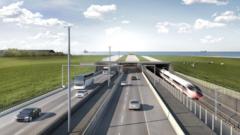**The nearly 18 km long Fehmarnbelt tunnel is set to reshape travel dynamics between Scandinavia and central Europe, with an expected completion in 2029.**
**Engineering Marvel: The Record-Breaking Baltic Tunnel Linking Denmark and Germany**

**Engineering Marvel: The Record-Breaking Baltic Tunnel Linking Denmark and Germany**
**A transformative infrastructure project aimed at reducing travel times and improving regional connectivity.**
The Fehmarnbelt tunnel, an ambitious undertaking stretching 18 kilometers beneath the Baltic Sea, is being constructed to enhance transportation between Denmark and Germany. This future record-breaking tunnel will provide a modern link, significantly cutting down travel time between Hamburg and Copenhagen.
As the world's longest pre-fabricated road and rail tunnel, the Fehmarnbelt will feature a unique construction method. Unlike traditional tunnels that tunnel beneath solid bedrock, this tunnel involves laying pre-manufactured segments on the seabed, which are then assembled, similar to how one might build with Lego bricks. The main construction site is located near Lolland, Denmark, spanning over 500 hectares and housing a factory dedicated to producing tunnel sections called "elements."
Henrik Vincentsen, the CEO of Femern, the state-owned Danish firm overseeing the project, emphasizes its innovative nature: “We are breaking records with this project,” he states. The €7.4 billion scheme has received support from the European Commission and is part of a broader European Union strategy aimed at strengthening travel links across the continent and promoting sustainable transport options.
Once operational, the tunnel will drastically reduce travel times, allowing a car trip between Rødbyhavn in Denmark and Puttgarten in Germany to take only 10 minutes, compared to the 45-minute ferry ride currently in use. Additionally, it will halve train travel between Copenhagen and Hamburg, minimizing both travel time and carbon emissions for commuters and freight.
As construction progresses, the logistical challenges of lowering the enormous tunnel segments, weighing over 73,000 tonnes each, into the sea are being overcome with sophisticated technology. The use of GPS-guided equipment enables precise positioning to ensure the segments are perfectly aligned on the seafloor.
Concerns regarding the ecological footprint of the project have been raised, particularly by environmental groups worried about the impact on local marine wildlife. However, in 2020, the German federal court dismissed legal challenges, allowing the project to proceed. In response to environmental concerns, measures have been put in place, including the creation of a wetland area aimed at mitigating negative impacts.
With the expected completion in 2029, estimates predict that the Fehmarnbelt tunnel will accommodate over 100 trains and 12,000 vehicles daily. Funding for the project relies on toll fees from users, which are projected to take approximately 40 years to repay the initial loans. Additionally, local economic benefits are anticipated, with hopes that increased connectivity will drive growth in one of Denmark's less affluent regions.
As construction advances on this monumental project, local communities remain optimistic about the potential for economic growth sparked by improved access to central Europe. As emphasized by senior construction manager Anders Gert Wede, the region’s residents are enthusiastic about the prospects for new business and tourism opportunities brought by the long-awaited tunnel.
As the world's longest pre-fabricated road and rail tunnel, the Fehmarnbelt will feature a unique construction method. Unlike traditional tunnels that tunnel beneath solid bedrock, this tunnel involves laying pre-manufactured segments on the seabed, which are then assembled, similar to how one might build with Lego bricks. The main construction site is located near Lolland, Denmark, spanning over 500 hectares and housing a factory dedicated to producing tunnel sections called "elements."
Henrik Vincentsen, the CEO of Femern, the state-owned Danish firm overseeing the project, emphasizes its innovative nature: “We are breaking records with this project,” he states. The €7.4 billion scheme has received support from the European Commission and is part of a broader European Union strategy aimed at strengthening travel links across the continent and promoting sustainable transport options.
Once operational, the tunnel will drastically reduce travel times, allowing a car trip between Rødbyhavn in Denmark and Puttgarten in Germany to take only 10 minutes, compared to the 45-minute ferry ride currently in use. Additionally, it will halve train travel between Copenhagen and Hamburg, minimizing both travel time and carbon emissions for commuters and freight.
As construction progresses, the logistical challenges of lowering the enormous tunnel segments, weighing over 73,000 tonnes each, into the sea are being overcome with sophisticated technology. The use of GPS-guided equipment enables precise positioning to ensure the segments are perfectly aligned on the seafloor.
Concerns regarding the ecological footprint of the project have been raised, particularly by environmental groups worried about the impact on local marine wildlife. However, in 2020, the German federal court dismissed legal challenges, allowing the project to proceed. In response to environmental concerns, measures have been put in place, including the creation of a wetland area aimed at mitigating negative impacts.
With the expected completion in 2029, estimates predict that the Fehmarnbelt tunnel will accommodate over 100 trains and 12,000 vehicles daily. Funding for the project relies on toll fees from users, which are projected to take approximately 40 years to repay the initial loans. Additionally, local economic benefits are anticipated, with hopes that increased connectivity will drive growth in one of Denmark's less affluent regions.
As construction advances on this monumental project, local communities remain optimistic about the potential for economic growth sparked by improved access to central Europe. As emphasized by senior construction manager Anders Gert Wede, the region’s residents are enthusiastic about the prospects for new business and tourism opportunities brought by the long-awaited tunnel.





















